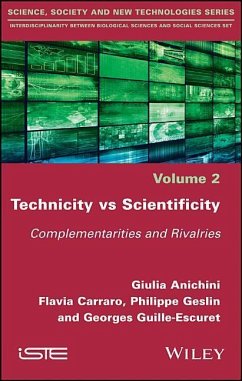Giulia Anichini, Flavia Carraro, Philippe Geslin, Georges Guille-Escuret
Technicity Vs Scientificity
Complementarities and Rivalries
Giulia Anichini, Flavia Carraro, Philippe Geslin, Georges Guille-Escuret
Technicity Vs Scientificity
Complementarities and Rivalries
- Gebundenes Buch
- Merkliste
- Auf die Merkliste
- Bewerten Bewerten
- Teilen
- Produkt teilen
- Produkterinnerung
- Produkterinnerung
The relationship between technicity and scientificity is often overlooked or avoided despite being a determining factor for establishing interdisciplinarity. By focusing on this relationship and highlighting a number of its ramifications, this book sheds light on the hidden or skewed stakes that condition a wide array of scientific projects. The authors present different approaches based on their own professional experience, focusing on the technique-science relationship in domains as diverse as brain mapping, the decipherment of Mycenaean writing and the design process. Each chapter presents…mehr
Andere Kunden interessierten sich auch für
![An empirical analysis of conventional VS Islamic microfinance programs An empirical analysis of conventional VS Islamic microfinance programs]() Zahoor KhanAn empirical analysis of conventional VS Islamic microfinance programs32,99 €
Zahoor KhanAn empirical analysis of conventional VS Islamic microfinance programs32,99 €![Few Dictators vs a Liberal Rebel Discourses on Economic Democracy Few Dictators vs a Liberal Rebel Discourses on Economic Democracy]() Alex BerhanuFew Dictators vs a Liberal Rebel Discourses on Economic Democracy42,99 €
Alex BerhanuFew Dictators vs a Liberal Rebel Discourses on Economic Democracy42,99 €![The Biology of Globalisation ¿ Indo-European Vs Aryo-Dravidian The Biology of Globalisation ¿ Indo-European Vs Aryo-Dravidian]() Ravikumar KurupThe Biology of Globalisation ¿ Indo-European Vs Aryo-Dravidian36,99 €
Ravikumar KurupThe Biology of Globalisation ¿ Indo-European Vs Aryo-Dravidian36,99 €![Midwives Vs Perturients Preferences of Birth Positions Midwives Vs Perturients Preferences of Birth Positions]() Lydia MwanziaMidwives Vs Perturients Preferences of Birth Positions26,99 €
Lydia MwanziaMidwives Vs Perturients Preferences of Birth Positions26,99 €![Behavioral Impact of Children Raised by Biological Parents vs Relative Behavioral Impact of Children Raised by Biological Parents vs Relative]() Tsegaab BekeleBehavioral Impact of Children Raised by Biological Parents vs Relative33,99 €
Tsegaab BekeleBehavioral Impact of Children Raised by Biological Parents vs Relative33,99 €![Media als socialisatiefactor voor kinderen in de VS Media als socialisatiefactor voor kinderen in de VS]() Zinaida __________Media als socialisatiefactor voor kinderen in de VS38,99 €
Zinaida __________Media als socialisatiefactor voor kinderen in de VS38,99 €![Critical Posthumanism and Planetary Futures Critical Posthumanism and Planetary Futures]() Critical Posthumanism and Planetary Futures119,99 €
Critical Posthumanism and Planetary Futures119,99 €-
-
-
The relationship between technicity and scientificity is often overlooked or avoided despite being a determining factor for establishing interdisciplinarity. By focusing on this relationship and highlighting a number of its ramifications, this book sheds light on the hidden or skewed stakes that condition a wide array of scientific projects. The authors present different approaches based on their own professional experience, focusing on the technique-science relationship in domains as diverse as brain mapping, the decipherment of Mycenaean writing and the design process. Each chapter presents varying and often opposing epistemological conclusions to provide the reader with a wide breadth of examples in different fields. Although the scope of this book is far from exhaustive, it serves as a starting point for the necessary and long-overdue clarification of the relationship between these neighboring, yet disjointed, sectors.
Hinweis: Dieser Artikel kann nur an eine deutsche Lieferadresse ausgeliefert werden.
Hinweis: Dieser Artikel kann nur an eine deutsche Lieferadresse ausgeliefert werden.
Produktdetails
- Produktdetails
- Verlag: Wiley
- Seitenzahl: 240
- Erscheinungstermin: 31. Juli 2017
- Englisch
- Abmessung: 234mm x 160mm x 18mm
- Gewicht: 476g
- ISBN-13: 9781786301369
- ISBN-10: 1786301369
- Artikelnr.: 48384411
- Herstellerkennzeichnung
- Libri GmbH
- Europaallee 1
- 36244 Bad Hersfeld
- gpsr@libri.de
- Verlag: Wiley
- Seitenzahl: 240
- Erscheinungstermin: 31. Juli 2017
- Englisch
- Abmessung: 234mm x 160mm x 18mm
- Gewicht: 476g
- ISBN-13: 9781786301369
- ISBN-10: 1786301369
- Artikelnr.: 48384411
- Herstellerkennzeichnung
- Libri GmbH
- Europaallee 1
- 36244 Bad Hersfeld
- gpsr@libri.de
Giulia Anichini, Centre interuniversitaire de recherche sur la science et la technologie (CIRST), Canada Flavia Carraro, Research Institute for the History of Technology and Science, Germany Philippe Geslin, Neuchâtel University of Applied Sciences, Switzerland Georges Guille-Escuret, French National Center for Scientific Research (CNRS), France
Introduction ix
Chapter 1 The Artisan, the Sage and the Irony: An Outline of Knowledge
Sociogenesis 1
Georges GUILLE-ESCURET
1.1 Knowledge sociogenesis? Necessary introduction 2
1.1.1 Evolution, history and conjecture: Radcliffe-Brown's block 3
1.1.2 Techniques outside science, science outside techniques 5
1.2 Extra-human or peri-human technicities 8
1.2.1 Involuntary society and impersonal knowledge: termite mound and
workers 8
1.2.2 Techniques and culture in chimpanzees 10
1.3 Junctions, divergences and disparities 11
1.3.1 Putting words to action? 12
1.3.2 Diversity and disparity, conjunction and separation 17
1.4 Forming a triangle: technique, science and ideology 23
1.4.1 Astronomers and architects, priests and administrators 25
1.4.2 Logic and theory without technique: first birth 30
1.4.3 Science thanks to techniques: second birth 34
1.5 The abandoned mystery: "technicity" 38
1.5.1 Immediate markers of technicity 40
1.5.2 Technicity, scientificity and ideology: the distinction of functions
with overlapping roles 44
1.6 Technocracy and scientificity 47
1.6.1 Technocracy: two perspectives in the 1960s 48
1.6.2 Technosciences: the example of molecular biology 51
1.7 The wilting of science, for lack of dissidence 54
Chapter 2 Technicization of the Neurosciences: Uses of Image-Processing
Software in Brain Research 57
Giulia ANICHINI
2.1 Setting the scene Neuroanatomy: from scalpel to screen 59
2.2 The categories challenged by practices 62
2.3 Sulcal morphometry: between automation and scientific expertise 64
2.3.1 Recovery and creation of "raw" data 64
2.3.2 Production of the "mask" 66
2.3.3 Choosing "normal" brain images 68
2.3.4 Labeling the sulci 72
2.4 Comparing brain networks: theory in database exploration 77
2.4.1 Defining the variables and comparing the groups of images 81
2.4.2 Data bricolage 87
2.5 Conclusions 90
Chapter 3 Cryptography, a Human Science? Models, Matrices, Tools and Frames
of Reference 97
Flavia CARRARO
3.1 Decipherment between science and technique, discovery and invention
98
3.1.1 Cryptographies between war and peace 99
3.1.2 An exemplary case: the decipherment of Linear B 103
3.2 The decipherer, the result and the procedure: the impossible solution
and the technical compromise 106
3.3 The Grid, tool, instrument and machine, and the regime of proofs and
tests 112
3.4 An applied and interdisciplinary internal and collective analysis 120
3.5 The patterns and mechanics of the documents 129
3.6 Scribes' hands and autopsy of the tablets 138
3.7 Technomycenology 144
3.7.1 Cuts of pertinence and relays, frames of reference and hierarchies
145
3.7.2 Prince Charming and the scribe of Minos 149
Chapter 4 The Beauty of Equation: The Anthropologist and the Engineer in
Design Processes 155
Philippe GESLIN
4.1 The "beauty of equation" 160
4.2 Eleven outlines for the harmony of the equation 163
4.2.1 First outline: the circulation of technical objects orients future
uses 163
4.2.2 Second outline: circulation can correct the "mistakes" or lack of a
design process 164
4.2.3 Third outline: circulation can encourage certain material, but also
discursive expansions 165
4.2.4 Fourth outline: circulation determines regimes of familiarity and
temporality that summarize technological standardization They can, in
certain cases, contribute to the birth of technoscapes 166
4.2.5 Fifth outline: the experience of techniques is the knowledge that
their deciders, or the public, have, and not necessarily those who directly
use it 168
4.2.6 Sixth outline: in the framework of circulating a technical object, it
is always through the element that constitutes it and that is the most
deterritorialized in relation to the context of receipt that specific forms
of appropriation are noted 169
4.2.7 Seventh outline: the choice of the name given to a technical object
before projects may constrain the design processes and its appropriation
mechanisms 170
4.2.8 Eighth outline: the relationships between things are just as much the
object of experiments as the things themselves 171
4.2.9 Ninth outline: the imitation principle underlies the circulation of
things and their "scale-up" 172
4.2.10 Tenth outline: the proposed solutions are both the process that will
lead to concrete transformations and its most visible results 173
4.2.11 Eleventh outline: the implementation of the sociotechnical points of
reference proposed by the anthropologist and their materialization favor
"acting together" and "testing the sensitive" 175
4.3 The blue note... 176
Conclusion 179
Bibliography 185
Index 203
Chapter 1 The Artisan, the Sage and the Irony: An Outline of Knowledge
Sociogenesis 1
Georges GUILLE-ESCURET
1.1 Knowledge sociogenesis? Necessary introduction 2
1.1.1 Evolution, history and conjecture: Radcliffe-Brown's block 3
1.1.2 Techniques outside science, science outside techniques 5
1.2 Extra-human or peri-human technicities 8
1.2.1 Involuntary society and impersonal knowledge: termite mound and
workers 8
1.2.2 Techniques and culture in chimpanzees 10
1.3 Junctions, divergences and disparities 11
1.3.1 Putting words to action? 12
1.3.2 Diversity and disparity, conjunction and separation 17
1.4 Forming a triangle: technique, science and ideology 23
1.4.1 Astronomers and architects, priests and administrators 25
1.4.2 Logic and theory without technique: first birth 30
1.4.3 Science thanks to techniques: second birth 34
1.5 The abandoned mystery: "technicity" 38
1.5.1 Immediate markers of technicity 40
1.5.2 Technicity, scientificity and ideology: the distinction of functions
with overlapping roles 44
1.6 Technocracy and scientificity 47
1.6.1 Technocracy: two perspectives in the 1960s 48
1.6.2 Technosciences: the example of molecular biology 51
1.7 The wilting of science, for lack of dissidence 54
Chapter 2 Technicization of the Neurosciences: Uses of Image-Processing
Software in Brain Research 57
Giulia ANICHINI
2.1 Setting the scene Neuroanatomy: from scalpel to screen 59
2.2 The categories challenged by practices 62
2.3 Sulcal morphometry: between automation and scientific expertise 64
2.3.1 Recovery and creation of "raw" data 64
2.3.2 Production of the "mask" 66
2.3.3 Choosing "normal" brain images 68
2.3.4 Labeling the sulci 72
2.4 Comparing brain networks: theory in database exploration 77
2.4.1 Defining the variables and comparing the groups of images 81
2.4.2 Data bricolage 87
2.5 Conclusions 90
Chapter 3 Cryptography, a Human Science? Models, Matrices, Tools and Frames
of Reference 97
Flavia CARRARO
3.1 Decipherment between science and technique, discovery and invention
98
3.1.1 Cryptographies between war and peace 99
3.1.2 An exemplary case: the decipherment of Linear B 103
3.2 The decipherer, the result and the procedure: the impossible solution
and the technical compromise 106
3.3 The Grid, tool, instrument and machine, and the regime of proofs and
tests 112
3.4 An applied and interdisciplinary internal and collective analysis 120
3.5 The patterns and mechanics of the documents 129
3.6 Scribes' hands and autopsy of the tablets 138
3.7 Technomycenology 144
3.7.1 Cuts of pertinence and relays, frames of reference and hierarchies
145
3.7.2 Prince Charming and the scribe of Minos 149
Chapter 4 The Beauty of Equation: The Anthropologist and the Engineer in
Design Processes 155
Philippe GESLIN
4.1 The "beauty of equation" 160
4.2 Eleven outlines for the harmony of the equation 163
4.2.1 First outline: the circulation of technical objects orients future
uses 163
4.2.2 Second outline: circulation can correct the "mistakes" or lack of a
design process 164
4.2.3 Third outline: circulation can encourage certain material, but also
discursive expansions 165
4.2.4 Fourth outline: circulation determines regimes of familiarity and
temporality that summarize technological standardization They can, in
certain cases, contribute to the birth of technoscapes 166
4.2.5 Fifth outline: the experience of techniques is the knowledge that
their deciders, or the public, have, and not necessarily those who directly
use it 168
4.2.6 Sixth outline: in the framework of circulating a technical object, it
is always through the element that constitutes it and that is the most
deterritorialized in relation to the context of receipt that specific forms
of appropriation are noted 169
4.2.7 Seventh outline: the choice of the name given to a technical object
before projects may constrain the design processes and its appropriation
mechanisms 170
4.2.8 Eighth outline: the relationships between things are just as much the
object of experiments as the things themselves 171
4.2.9 Ninth outline: the imitation principle underlies the circulation of
things and their "scale-up" 172
4.2.10 Tenth outline: the proposed solutions are both the process that will
lead to concrete transformations and its most visible results 173
4.2.11 Eleventh outline: the implementation of the sociotechnical points of
reference proposed by the anthropologist and their materialization favor
"acting together" and "testing the sensitive" 175
4.3 The blue note... 176
Conclusion 179
Bibliography 185
Index 203
Introduction ix
Chapter 1 The Artisan, the Sage and the Irony: An Outline of Knowledge
Sociogenesis 1
Georges GUILLE-ESCURET
1.1 Knowledge sociogenesis? Necessary introduction 2
1.1.1 Evolution, history and conjecture: Radcliffe-Brown's block 3
1.1.2 Techniques outside science, science outside techniques 5
1.2 Extra-human or peri-human technicities 8
1.2.1 Involuntary society and impersonal knowledge: termite mound and
workers 8
1.2.2 Techniques and culture in chimpanzees 10
1.3 Junctions, divergences and disparities 11
1.3.1 Putting words to action? 12
1.3.2 Diversity and disparity, conjunction and separation 17
1.4 Forming a triangle: technique, science and ideology 23
1.4.1 Astronomers and architects, priests and administrators 25
1.4.2 Logic and theory without technique: first birth 30
1.4.3 Science thanks to techniques: second birth 34
1.5 The abandoned mystery: "technicity" 38
1.5.1 Immediate markers of technicity 40
1.5.2 Technicity, scientificity and ideology: the distinction of functions
with overlapping roles 44
1.6 Technocracy and scientificity 47
1.6.1 Technocracy: two perspectives in the 1960s 48
1.6.2 Technosciences: the example of molecular biology 51
1.7 The wilting of science, for lack of dissidence 54
Chapter 2 Technicization of the Neurosciences: Uses of Image-Processing
Software in Brain Research 57
Giulia ANICHINI
2.1 Setting the scene Neuroanatomy: from scalpel to screen 59
2.2 The categories challenged by practices 62
2.3 Sulcal morphometry: between automation and scientific expertise 64
2.3.1 Recovery and creation of "raw" data 64
2.3.2 Production of the "mask" 66
2.3.3 Choosing "normal" brain images 68
2.3.4 Labeling the sulci 72
2.4 Comparing brain networks: theory in database exploration 77
2.4.1 Defining the variables and comparing the groups of images 81
2.4.2 Data bricolage 87
2.5 Conclusions 90
Chapter 3 Cryptography, a Human Science? Models, Matrices, Tools and Frames
of Reference 97
Flavia CARRARO
3.1 Decipherment between science and technique, discovery and invention
98
3.1.1 Cryptographies between war and peace 99
3.1.2 An exemplary case: the decipherment of Linear B 103
3.2 The decipherer, the result and the procedure: the impossible solution
and the technical compromise 106
3.3 The Grid, tool, instrument and machine, and the regime of proofs and
tests 112
3.4 An applied and interdisciplinary internal and collective analysis 120
3.5 The patterns and mechanics of the documents 129
3.6 Scribes' hands and autopsy of the tablets 138
3.7 Technomycenology 144
3.7.1 Cuts of pertinence and relays, frames of reference and hierarchies
145
3.7.2 Prince Charming and the scribe of Minos 149
Chapter 4 The Beauty of Equation: The Anthropologist and the Engineer in
Design Processes 155
Philippe GESLIN
4.1 The "beauty of equation" 160
4.2 Eleven outlines for the harmony of the equation 163
4.2.1 First outline: the circulation of technical objects orients future
uses 163
4.2.2 Second outline: circulation can correct the "mistakes" or lack of a
design process 164
4.2.3 Third outline: circulation can encourage certain material, but also
discursive expansions 165
4.2.4 Fourth outline: circulation determines regimes of familiarity and
temporality that summarize technological standardization They can, in
certain cases, contribute to the birth of technoscapes 166
4.2.5 Fifth outline: the experience of techniques is the knowledge that
their deciders, or the public, have, and not necessarily those who directly
use it 168
4.2.6 Sixth outline: in the framework of circulating a technical object, it
is always through the element that constitutes it and that is the most
deterritorialized in relation to the context of receipt that specific forms
of appropriation are noted 169
4.2.7 Seventh outline: the choice of the name given to a technical object
before projects may constrain the design processes and its appropriation
mechanisms 170
4.2.8 Eighth outline: the relationships between things are just as much the
object of experiments as the things themselves 171
4.2.9 Ninth outline: the imitation principle underlies the circulation of
things and their "scale-up" 172
4.2.10 Tenth outline: the proposed solutions are both the process that will
lead to concrete transformations and its most visible results 173
4.2.11 Eleventh outline: the implementation of the sociotechnical points of
reference proposed by the anthropologist and their materialization favor
"acting together" and "testing the sensitive" 175
4.3 The blue note... 176
Conclusion 179
Bibliography 185
Index 203
Chapter 1 The Artisan, the Sage and the Irony: An Outline of Knowledge
Sociogenesis 1
Georges GUILLE-ESCURET
1.1 Knowledge sociogenesis? Necessary introduction 2
1.1.1 Evolution, history and conjecture: Radcliffe-Brown's block 3
1.1.2 Techniques outside science, science outside techniques 5
1.2 Extra-human or peri-human technicities 8
1.2.1 Involuntary society and impersonal knowledge: termite mound and
workers 8
1.2.2 Techniques and culture in chimpanzees 10
1.3 Junctions, divergences and disparities 11
1.3.1 Putting words to action? 12
1.3.2 Diversity and disparity, conjunction and separation 17
1.4 Forming a triangle: technique, science and ideology 23
1.4.1 Astronomers and architects, priests and administrators 25
1.4.2 Logic and theory without technique: first birth 30
1.4.3 Science thanks to techniques: second birth 34
1.5 The abandoned mystery: "technicity" 38
1.5.1 Immediate markers of technicity 40
1.5.2 Technicity, scientificity and ideology: the distinction of functions
with overlapping roles 44
1.6 Technocracy and scientificity 47
1.6.1 Technocracy: two perspectives in the 1960s 48
1.6.2 Technosciences: the example of molecular biology 51
1.7 The wilting of science, for lack of dissidence 54
Chapter 2 Technicization of the Neurosciences: Uses of Image-Processing
Software in Brain Research 57
Giulia ANICHINI
2.1 Setting the scene Neuroanatomy: from scalpel to screen 59
2.2 The categories challenged by practices 62
2.3 Sulcal morphometry: between automation and scientific expertise 64
2.3.1 Recovery and creation of "raw" data 64
2.3.2 Production of the "mask" 66
2.3.3 Choosing "normal" brain images 68
2.3.4 Labeling the sulci 72
2.4 Comparing brain networks: theory in database exploration 77
2.4.1 Defining the variables and comparing the groups of images 81
2.4.2 Data bricolage 87
2.5 Conclusions 90
Chapter 3 Cryptography, a Human Science? Models, Matrices, Tools and Frames
of Reference 97
Flavia CARRARO
3.1 Decipherment between science and technique, discovery and invention
98
3.1.1 Cryptographies between war and peace 99
3.1.2 An exemplary case: the decipherment of Linear B 103
3.2 The decipherer, the result and the procedure: the impossible solution
and the technical compromise 106
3.3 The Grid, tool, instrument and machine, and the regime of proofs and
tests 112
3.4 An applied and interdisciplinary internal and collective analysis 120
3.5 The patterns and mechanics of the documents 129
3.6 Scribes' hands and autopsy of the tablets 138
3.7 Technomycenology 144
3.7.1 Cuts of pertinence and relays, frames of reference and hierarchies
145
3.7.2 Prince Charming and the scribe of Minos 149
Chapter 4 The Beauty of Equation: The Anthropologist and the Engineer in
Design Processes 155
Philippe GESLIN
4.1 The "beauty of equation" 160
4.2 Eleven outlines for the harmony of the equation 163
4.2.1 First outline: the circulation of technical objects orients future
uses 163
4.2.2 Second outline: circulation can correct the "mistakes" or lack of a
design process 164
4.2.3 Third outline: circulation can encourage certain material, but also
discursive expansions 165
4.2.4 Fourth outline: circulation determines regimes of familiarity and
temporality that summarize technological standardization They can, in
certain cases, contribute to the birth of technoscapes 166
4.2.5 Fifth outline: the experience of techniques is the knowledge that
their deciders, or the public, have, and not necessarily those who directly
use it 168
4.2.6 Sixth outline: in the framework of circulating a technical object, it
is always through the element that constitutes it and that is the most
deterritorialized in relation to the context of receipt that specific forms
of appropriation are noted 169
4.2.7 Seventh outline: the choice of the name given to a technical object
before projects may constrain the design processes and its appropriation
mechanisms 170
4.2.8 Eighth outline: the relationships between things are just as much the
object of experiments as the things themselves 171
4.2.9 Ninth outline: the imitation principle underlies the circulation of
things and their "scale-up" 172
4.2.10 Tenth outline: the proposed solutions are both the process that will
lead to concrete transformations and its most visible results 173
4.2.11 Eleventh outline: the implementation of the sociotechnical points of
reference proposed by the anthropologist and their materialization favor
"acting together" and "testing the sensitive" 175
4.3 The blue note... 176
Conclusion 179
Bibliography 185
Index 203








